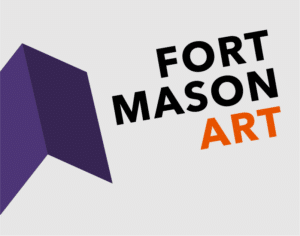Sofie Ramos: Space to Breathe
THIS EXHIBIT HAPPENED AUGUST 10
THROUGH DECEMBER 31, 2018.
Fort Mason Center for Arts & Culture (FMCAC) was pleased to present Sofie Ramos: Space to Breathe. In her new commission for FMCAC, Sofie Ramos inhabits three entry sites to the Fort Mason campus: the 1926 Guardhouse, the power transformer, and the driveway separating the two. Ramos’ fantastical installations suggest a painting expanding into space and often engulfing the viewer. Her playful use of vibrant color and exaggerated shape transforms everyday objects and interiors into their extroverted and dream-like cousins.
Ramos remade the Guardhouse as a miniature play house, visible only through the structure’s four windows. Chris Wood’s ambient soundscape highlighted the contrasting energies at the heart of the piece, as the score called us to spy a room we can never enter. The overabundant interior too sat close to a creeping claustrophobia, as a viewer imagined life within the crowded enclosure.
This push and pull of exuberance and restriction continued across the installation, as line drawings on the ground paralleled the pedestrian crosswalk and lead viewers to a fantasy fence. Concealing the working power transformer, Ramos’ mural-like painting recalled children’s forts, carnival architectures, and fairy tales. A story waited to be told about setting out or coming home, about guarded treasures or safe houses, about the things we can see and the sights we imagine behind every wall.
About Sofie Ramos
Oakland-based Ramos creates installations that are inspired by everyday material culture, curating found objects and patterns to make the mundane strange through form, color, and whimsy. Her site-specific work is known for its colorful chaos and continuous evolution. Ramos has shown at Mixed Greens gallery in New York, Swim Gallery in San Francisco, and Johansson Projects in Oakland, and she is an alum of the Artist in Residence program at Facebook HQ, where she is the only artist with three permanent installations.
Artist Statement
“Being is alternately condensation that disperses with a burst, and dispersion that flows back to a center. Outside and inside are both intimate—they are always ready to be reversed, to exchange their hostility.” — Gaston Bachelard, The Poetics of Space
Incorporating the architecture of the existing space as well as sculptural constructions and found objects, my aggressive and excessive installation-based paintings seek to occupy, (re)define and (re)configure empty or unused spaces, while still leaving boundaries open or ambiguous, or at least permeable. The work prioritizes physicality and progression as it responds/adapts to, fuses with, and adulterates its surroundings. Endlessly activated by layers and layers of paint, objects and spaces continually evolve and recombine, concentrating the weight of meaning in the sum of the processes of making and remaking rather than in a finished state or resolved composition. The improvisational and inconclusive acts of accumulating, arranging, reusing and reworking layers of visual material become negotiations of space, body and material—encountering, interacting, enveloping and overwhelming each other—embodying underlying tensions in the fluidity of formal and psychological oppositions.
Fort Mason’s tiny Guardhouse space was crammed with domestic forms and layered with saturated hues of house paint to create a lusciously absurd, claustrophobic environment that grew and evolved over the duration of the installation. The space became a habitat which required constant maintenance, grooming, and rearranging in order to avoid agitation and chaotic mania. In addition to the living and evolving interior, the space was activated periodically by performers acting out spatial dramas vacillating between excess and emptying out, inhaling and exhaling, confinement, and liberation.
A series of paths meandering in and out of the Guardhouse acted to guide activity around the space, but they were permeated with obstructions and distractions that prevented fluid movement through them. Connecting this intimate, enclosed space with its exterior surrounding, the paths created a web of escapes and entrances that always circled back to themselves and perpetuated a relentless exchange of security and freedom. True freedom might exist in deviation from the path in the outside world, but the seduction of security always led followers back to the comforts of captivity.
Though there was necessity for expanding, there was also consolation in contracting. The objective, then, was not so much an escape from excess and claustrophobia so much as it was an attempt at assimilating to it, nesting, finding refuge. The exhibit considered the relations between physical structures and mental states, the effects of accumulation, clutter, and proximity, and the battling compulsions to fill space and to find space to breathe.

